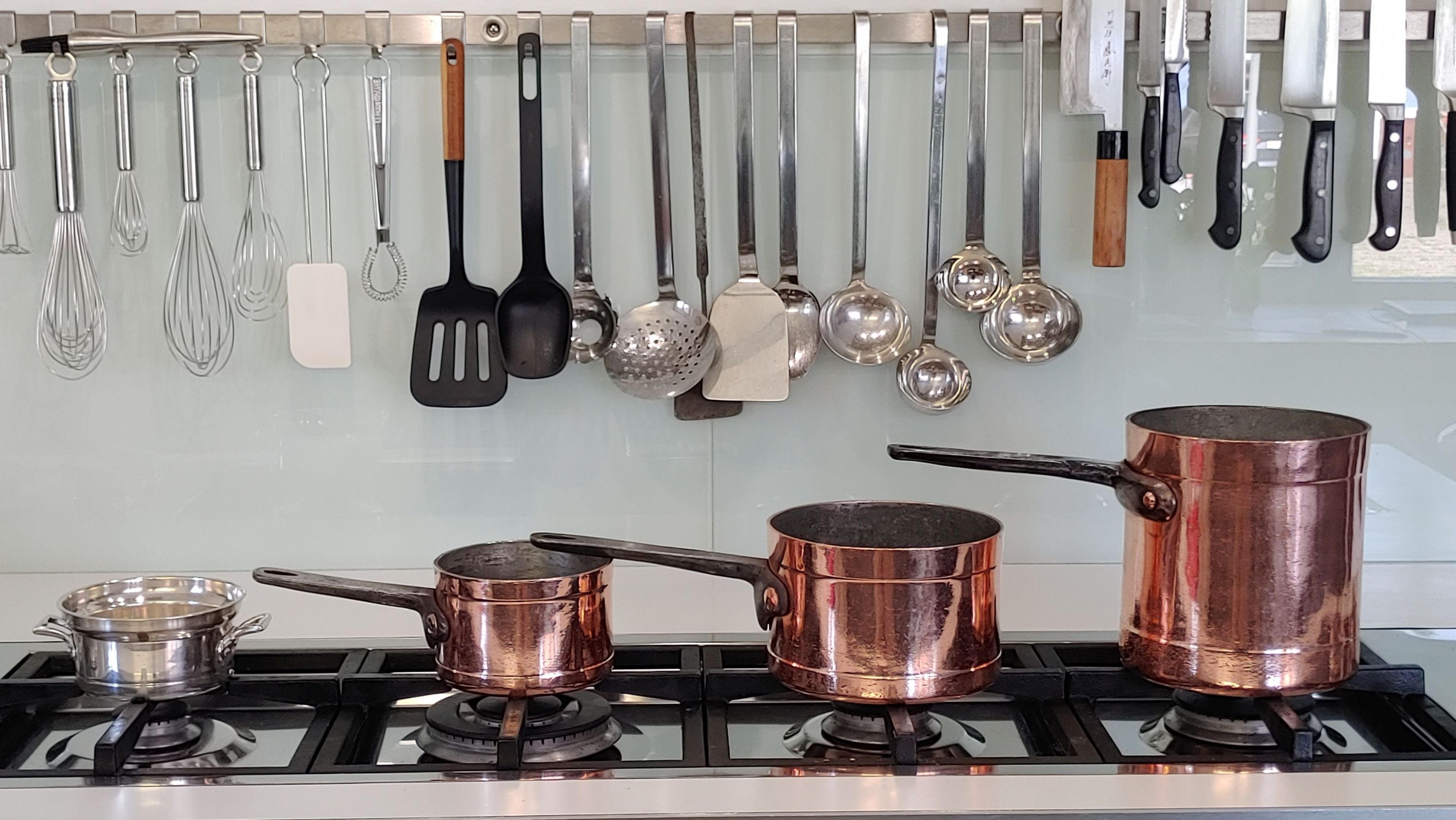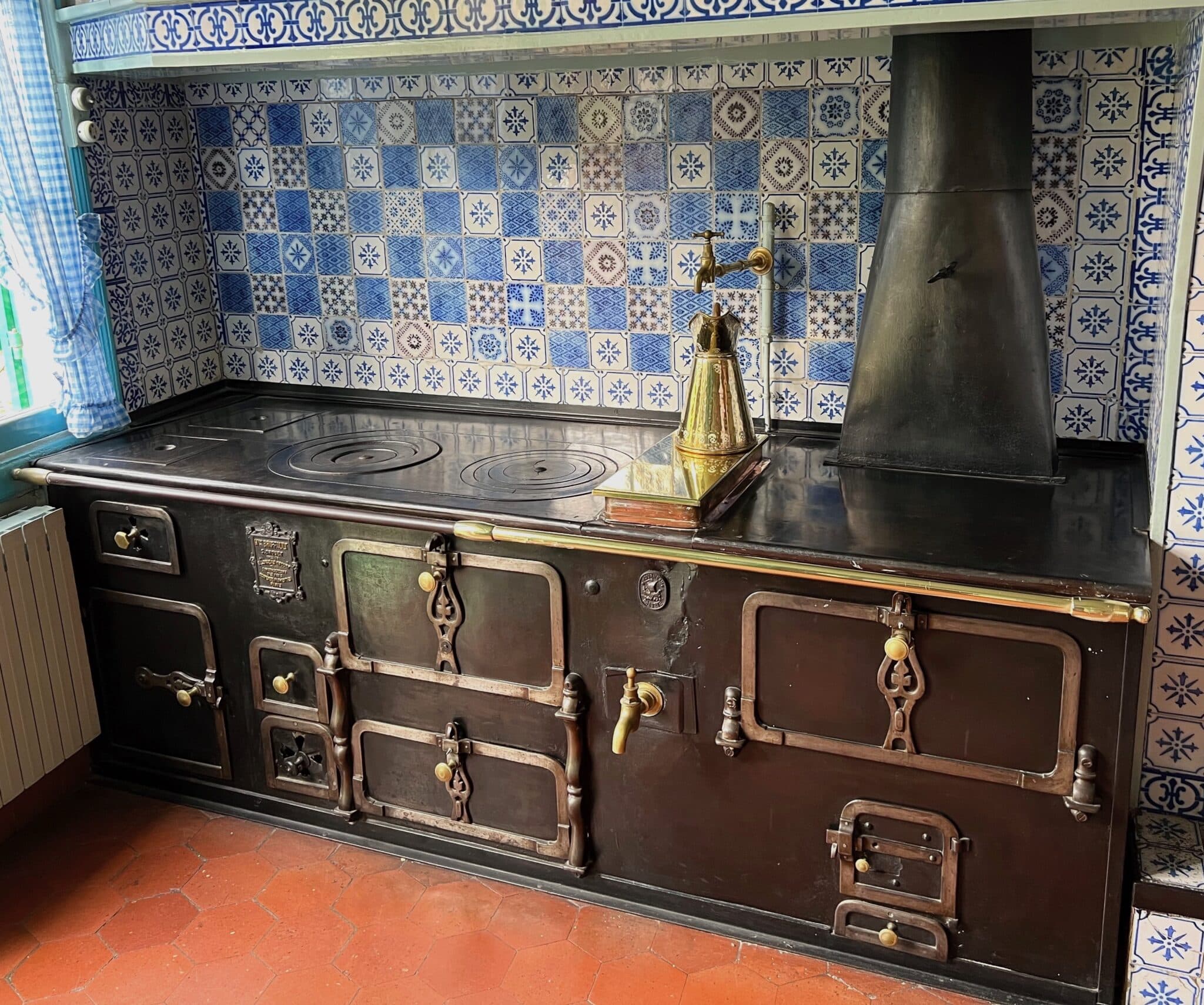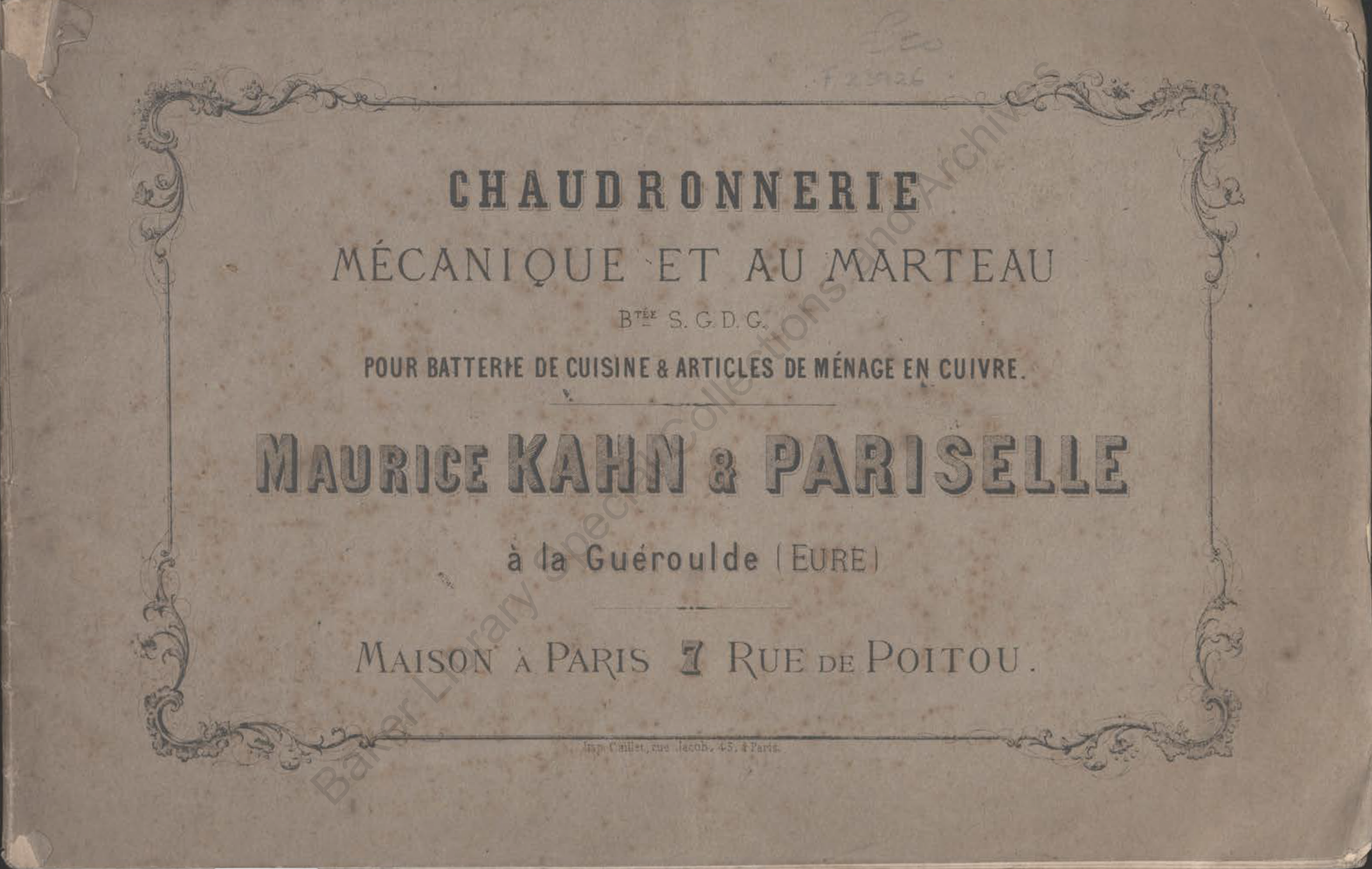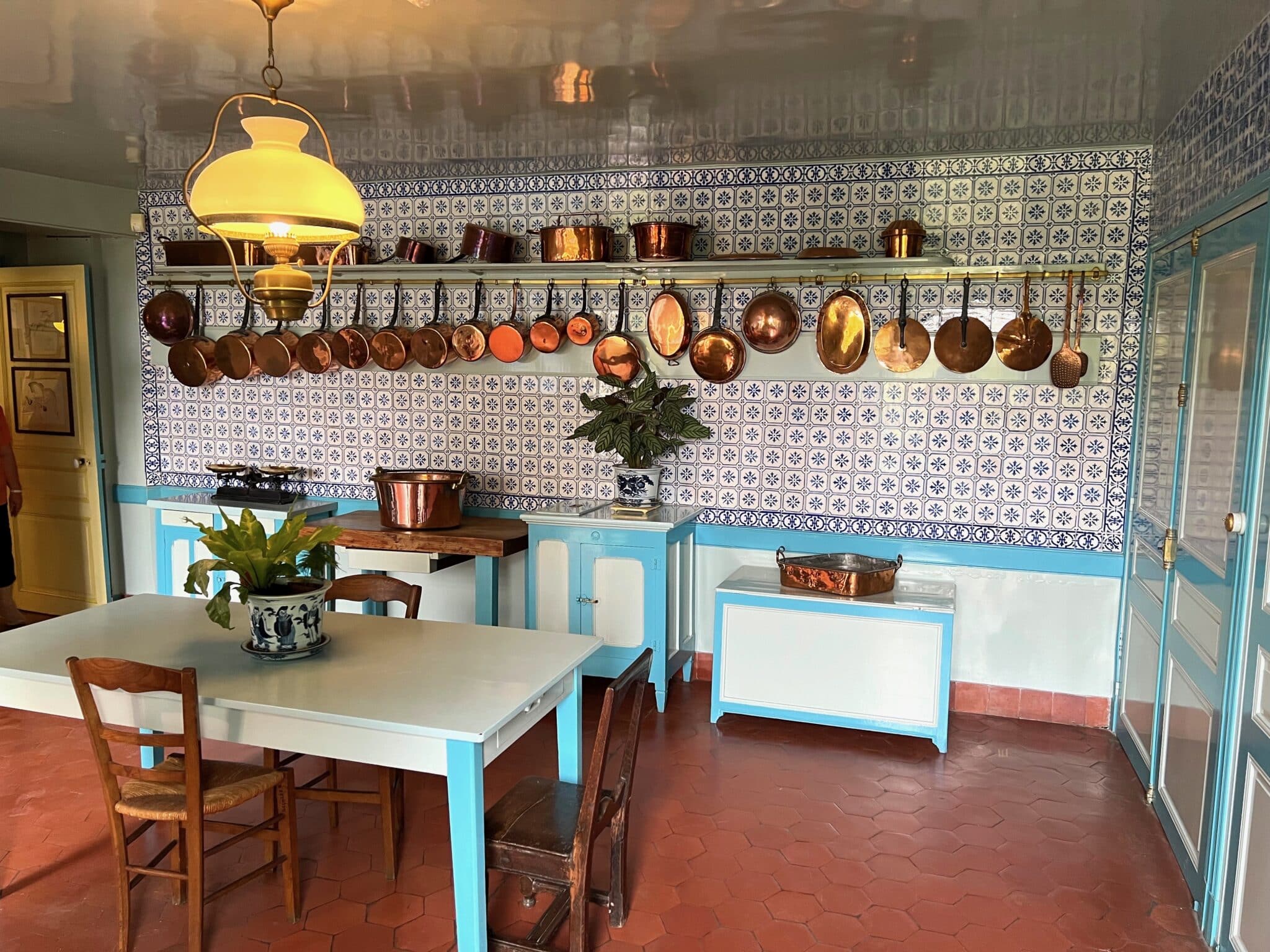“After a while I was quite astonished, when under the thick oxide layer suddenly a company stamp appeared.”
VFC says: Please enjoy this guest post by Gerhard about his investigation into two lesser-known German coppersmiths.
Several times here on VFC I have become aware of the German company Gebrüder Schwabenland. The company produced high-quality copper pots and also designed and manufactured commercial kitchens for hotels and restaurants. For the pots, they had developed a particular process to save material and thus weight in less-stressed areas. This gives them a very distinctive look that is unmistakable. Today, the company is headquartered in Berlin and manufactures only commercial kitchens. Martin wrote a wonderful article about this on VFC almost exactly two years ago. I would like to add a few additions here.
At a flea market in my hometown of Karlsruhe, Germany, I found an inconspicuous copper pot, placed under the sales counter, that looked as if it had been forgotten in a cellar for decades. It was oxidized a deep dark brown, but you could see the typical Gebrüder Schwabenland shape. That’s why I bought it.

Pretty soon it was clear to me that I wouldn’t get anywhere here with baking soda, because there was hardly any organic debris to remove. So straight to the polishing machine. In order not to remove too much original substance, I started with a medium grit for the polishing pastes. After a while I was quite astonished, when under the thick oxide layer suddenly a company stamp appeared, which was not visible before. It was only very lightly stamped and only partially legible.

The following could be read:
C.A. BRAI…
…ALLWAREN
…LINGEN ᴀ N
The first line is certainly the company name.
The middle line definitely means “Metallwaren”, which means metal goods in English.
The third line is the city, but which one? Now the following helps here: Postal codes have existed in Germany only since 1941, and before that, in some cities, the name was supplemented with a clue to avoid confusion — almost always the name of a river on which the city is located. In our case, it says “ᴀ N”. The river must be large, so that even people who live far away know it. Therefore, I looked for a city that ends with “lingen” and is located on a river that begins with the letter N. At first Solingen came to my mind, where there are a large number of tool companies and especially cutleries. But in Solingen there is no river beginning with N. The only major river with N in Germany is the Neckar — and what do I see: Right next to Stuttgart is Esslingen am Neckar!
Now all that’s missing is the complete company name. Unfortunately, I can’t get any further with today’s business directories from Esslingen. I wrote to the local Esslingen city museum and asked if they can help me. The deputy director answered me that it is the company C. A. Braig, of which they have several exhibits in the museum. She also sends me two excerpts from the 1927 trade directory, in which the Braig company appears twice:


It is listed there as a metal spinning company and a metal goods factory. In her reply mail she also writes me that the Braig company is neither listed in the 1925 nor in the 1929 book — only in 1927! This could mean that it was only located in Esslingen for a short time or that it was taken over by another company. If I wanted to know more precisely, I should send an inquiry to the economic archive at the University of Hohenheim. Company documents can usually be found there. Unfortunately, the archives could not help me, as they had no documentation on this.
In the meantime, I was very interested in finding out what else C.A. BRAIG made. In Kleinanzeigen, a German classified advertisements site, it is very rare to discover something from the company. But at the beginning of May I found a silver-plated pot advertised — with no information about size and weight, only photos of the hallmarks on the bottom of the pot. But since it looked cute and was not expensive, I bought it.
When I opened the package, I almost had to laugh because the pot was so small — diameter at the rim 12 cm, pot body 10 cm, height 6 cm. I can’t say anything about the base material — the pot is a bit too light for copper. Maybe aluminum? It weighs only 333 g with a wall thickness of approx. 1.2 mm.
After polishing it looked almost like new:


And here you can see the hallmark on the bottom of the pot — before polishing:

Despite the small size, it has all the details of a larger pot, even three small rivets per handle. The seller told me that she had taken the pot to a jeweler to have its value appraised. He said that such small pots were occasionally made as anniversary gifts to deserving employees. Anyway, I can’t use it for cooking, but it looks fun.

At about the same time that I found the small silver-plated pot, an advertisement also appeared for four copper pots — two from Gebrüder Wagner, Esslingen and two from C. A. Braig, Esslingen. Interestingly, all four pots had the same material-saving design as the pots from Gebrüder Schwabenland described at the beginning.

Since the offer seemed too expensive and I was only interested in the two Braig pots, I waited. After a month, the price was lowered, and again two weeks later. I made an offer for the two Braig pots, which are the two small ones in the picture, and got the contract. I didn’t want the two larger Wagner pots because I already had my first Braig pot in similar dimensions — the Bain Marie. Both pots came in pretty good condition.

After polishing, they now look like this:

Both have a very similar straight handle shape to the bain-marie I found at the flea market. This handle may not look as elegant as the French handle shapes, but seems to me to be more ergonomic because you don’t have to bend your wrist as far when lifting. Martin has already written about this in his essay
Oddly, the handles on the two smaller pots are attached differently than on the larger one:

Here is the attachment to the smaller pots. The rivets are very large and certainly not prefabricated.

Here is the situation on the larger Bain Marie with much smaller (probably prefabricated?) rivets. But if you take a careful look at the close-up area directly around the rivets, you get the impression that there is room for larger “mushroom head” rivets. The completely different shape of the handle’s head plate is striking: narrow and rectilinear on the larger pot, heart-shaped on the smaller ones. Due to the higher weight, I would have guessed it the other way around.
These two pictures show my “Braig collection” — maybe it will grow on occasion.


A few numbers:
- Bain Marie: diameter 16 cm, height 18 cm, weight 2,788 g, wall thickness at rim 3.5 mm. This raises a question for me: Why does a bain marie has such a thick wall? What for? At the moment I can not use it because the tinning is very poor.
- Larger Casserole: diameter 16 cm, height 11 cm, weight 1.964 g, wall thickness at rim 3.0 mm. Tinning found in good condition.
- Small Casserole: diameter 12 cm, height 8.5 cm, weight 1.169 g, wall thickness at rim also 3.0 mm. Tinning found in good condition too.
For the sake of completeness, I have here a photo of the stamp on the two Bain Maries from Gebrüder Wagner:

Conclusion
To return to Martin’s essay: C.A. Braig and also Gebrüder Wagner, both surprisingly from Esslingen, can be added to the list of companies that adopted the construction method developed by Schwabenland. This also fits well with the excerpts from the Esslingen address book of 1927 — the year in which the patents of the “Gebrüder Schwabenland” expired. I have not yet researched the “Gebrüder Wagner”. It would be interesting to know what their relationship was to C.A. Braig.
VFC says: Gerhard, thank you so much for this research! These additional examples of German pieces provide yet more evidence that this straight-shaft handle style represents a consistent aesthetic across multiple makers. And of course the thicker bands around the rim and base as well.
I find the small silver-plated pot to be especially charming. As you note, it looks beautifully made and perfectly proportioned — I would not have guessed that it was so small in diameter! I agree that 333g is quite light and I also wonder what the base metal could be.






Gerhard, I congratulate you on your finds and thank you for your dedicated and insightful research on BRAIG. The similarity between these pots and those of GEBR. SCHWABENLAND is unmistakable. Therefore, your assumption that the distinctive design of “Schwabenland” could be taken over by other companies when the patent protection expired is quite understandable. Where does your information come from that this patent ended in 1927?
Since the German company WAGNER also had heavyweight pots with this design in their program for a while, although this manufacturer normally produced much thinner-walled copper tableware for the „normal“ household, I have another guess. Since Schwabenland had to declare bankruptcy in the course of the world economic crisis in about 1934, interested companies could acquire pots and machines from the estate and now distribute them with their own stamp and possibly also produce them themselves.
To make things even trickier, there are also sauté pans from the small Swiss manufacturer MANZONI that also have reinforcements on the top rim and bottom. One of these sauté pans was featured in the “Guest Post: Passion or obsession”. Irritatingly, Paul Manzoni made his pans by hand until the 1940s. So how did he manage to copy this design with the “reinforcing rings”? The design of Manzoni’s handles, however, is an applied Schwabenland design. While the handle itself is flat as usual, the connecting plate is a kind of rectangle or “sausage”. A very heavy casserole from another Swiss coppersmith that I recently acquired has a similar handle. I already have trouble indicating this pot in the usual way when empty. Filled, I succeed at best with a trick that proves the merits of this design. I grab the handle near the mounting plate and rest my forearm on the flat handle.
The history of CHRISTIAN WAGNER, Esslingen, Southwest Germany, as I know it:
The roots of the traditional company go back to the year 1524, when Peter Wagner, master coppersmith, acquired the citizenship of the city of Nördlingen. Since then, the copper craft has been passed down from father to son through 15 generations without interruption. Nördlingen, Heidenheim, Stuttgart and Esslingen are the cities where the wainwrights of this line worked. The founder of the Esslingen line was Christian Wagner (1740-1811), who moved from Stuttgart to Esslingen in 1769. His workshop was the common origin of the Christian Wagner and Wilhelm Wagner metalware factories. In 1992, Christian Wagner moved from its old location in Esslingen to a new building in Deizisau. The Christian Wagner metalware factory, famous for its copperware, filed for bankruptcy in August 1995.
Especially baking molds, which can also be hung on the wall as a decorative element, dominated the company’s product range for many years. In addition to “Gugelhupf” molds, the animal molds were particularly popular. The motifs here were varied and ranged from fish and lobster shapes to small turtles.
Hello Martin,
thank you very much for your extensive answer, especially the encyclopedic information about the Wagner dynasty! Too bad that they had to close after such a long time.
Regarding your question about the source information on the end of patent protection of the Schwabenland design: I got that from your great article on the Schwabenland brothers. There, directly in the paragraph below the photo with Schwabenland’s original coffee machine is the following:
…as mentioned in the 1927 catalog. “Today, after the protection period has expired, our design is copied across the board.”
Since this was already mentioned in writing in the 1927 catalog, it is quite conceivable that the patent had expired even somewhat earlier.
Thank you Gerhard for correcting me, even though I’ve noticed the memory gap myself by looking through the 1927 catalogue. Well, increasing forgetfulness is a toll of old age. I’m sorry.
Hello Gerhard, among the numerous examples and variants of Schwabenland stamps in my library there is also a specimen that is additionally stamped the Wagner stamp.
Correction translation error: to lift the pot or lifting the pot
I love learning new things with my morning tea. Well done! Thank you VFC, Gerhard, and Martin!
The trade directory shows a metal spinning shop and a metal goods factory KARL U. (?) BRAIG in Martinstr. 43. Since the first name Karl does not match any of the initials C. A., I wonder if this is indeed the company C.A. Braig we are looking for. By the way, Metallwarenfabrik Christian Wagner is also listed on page 346 in the yellow pages.
In the meantime, I have searched several Internet archives myself without having obtained any relevant result. It is very likely that many documents that would be helpful to us were destroyed in the war. Industrial cities like Stuttgart and the surrounding area were preferred targets of attack for understandable reasons. However, it also cannot be ruled out that C.A. Braig was a relatively small manufacturer or even “just” a store that was not well documented.
A question for Gerhard: I assume you measured the thickness of the copper at the top edge. The wall thickness below this striking reinforcement is therefore less. Unfortunately, I was only able to estimate this area of the side wall of my pans due to the lack of a suitable measuring device. But the thickness is certainly above average.
Since the design of the handles and the riveting techniques (manual vs. machine) are different, it reinforces my assumption that both Braig and Wagner acquired partially manufactured material, a “kit” so to speak, and only did the finishing of the pots. The copper cubes could only be made in a factory that had large pressing machines, i.e. Gebr. Schwabenland (see photo in my post). Since even at the beginning of industrialization, whose essence was specialization and mass production, more and more subcontractors were created, I think it is quite likely that the handles came from one of these subcontractors. A small company, like probably Braig, would not have bought a riveting machine, but would have pressed the rivets in by hand with hammer blows, as the presented pans show very nicely. Wagner, on the other hand, was a factory that certainly had riveting machines. Wagner only processed thin-walled copper into pans and baking pans for decades, therefore, the production of heavy copper pots in the “Schwabenland design” would only have been possible if they had acquired at least one of the huge pressing machines from the estate of Gebr. Schwabenland. Such an enormous and costly expansion of the factory’s equipment would certainly have been reported, but I could not find anything corresponding. Also keep in mind that not only Gebr. Schwabenland suffered from the economic crisis in the 1930s, but probably most companies. It is difficult for me to imagine that Wagner could make such an investment in these times of crisis.
I therefore stick to my thesis that remaining stocks from the production of Schwabenland were bought up and then offered with their own label. But since one quickly gets into mental impasses with “talking to oneself,” I would be happy about a response from the readers.
Only on the smaller Casserole could I measure both the rim and the thinner area with the micrometer screw. They were 3.0 mm and 2.2 mm. The bottom I could measure with the caliper – 3.0 mm.
The bain-marie has a rim thickness of 3.5 mm, but here the rim is too wide for measurements below that. However, I estimate that the pot underneath is still 3.0 mm thick, so was pressed less. It looks to me almost like an experimental piece or made by an apprentice. The two casseroles look more professional somehow.
The thesis with the remnants sounds plausible to me. But then the question arises: Did Schwabenland sell unfinished pieces earlier? Because, as we know, Schwabenland filed for bankruptcy in 1934 and Braig is listed in the trade directory in 1927.
I have once again dealt with the excerpt from the trade directory. This old German font is not easy to read, especially since the copy is also a little blurry. It’s probably called a “fracture”. This typeface was in use from the 16th to the early 20th century. I initially read the second abbreviated letter as U, but added a question mark. But now that I’ve looked for other unique uppercase U’s, I have to discard that assumption. Then I compared several A’s and came to the conclusion that it must indeed be an A’. It remains for Karl to be enlightened. But there could be a solution here too. I remembered that “Karl” is sometimes spelled as “Carl” in German. It’s going to be more unusual and Nordic. If so, “Karl A. Braig” from the trade directory would match the stamp “C.A. Braig”. Hopefully! phew
Yes, that’s right, the font is called Fraktur.
And there are indeed some names in German that can be written with both “K” and “C” – Carl, Conrad, Claus…
Possibly C.A. Braig simply found it more “international” to write his name with “C”, since the variant with “K” is mainly used in German-speaking countries.
The small, round cocotte was probably once part of Gebr. Schwabenland’s comprehensive range. In the 1927 catalog, however, only the oval shape with a lid is listed as “Serving casserole à la Adlon”. However, the design is completely identical. They were available in various sizes, both tinned and silver-plated on the inside. I owned this oval serving casserole myself, stamped “Original Schwabenland”, and have photos of an even larger and significantly heavier variant, also oval. The latter has two stamps: “Original Schwabenland” and “Hotel Bellevue Gion”. Numerous star chefs were trained in this hotel on Lake Geneva. There were other serving dishes silver-plated in different ways. In addition, variants in alpaca, pure nickel, nickel-plated and aluminum.
Hallo Gerhard, falls du dich etwas näher mit der Geschichte der Metallwarenfabrik WAGNER befassen möchtest, hätte ich hier einen Tipp:
https://www.zvab.com/buch-suchen/autor/metallwarenfabrik-wagner/
Vor längere Zeit sah ich noch ein weiteres antiquarisches Buch, das jedoch inzwischen vergriffen ist.
Über BRAIG habe ich gründlich in sämtlichen örtlichen, regionalen und landesweiten Archiven recherchiert, zuletzt noch im Esslinger Adressbuch von 1931 – es war leider rein gar nichts über diese Firma zu finden.
Gerhard, similar measurements and estimates were also made for my Schwabenland pans. I would love to have a gauge that would measure the thickness of the sidewall from top to bottom. Gaillard advertises its top line with a conical thickening of the wall towards the base. I tried in vain to feel this manually when I let my hands slide down parallel on the outside and inside. Gaillard didn’t feel any different than other saucepans. But of course this was not a serious test. But I have an idea: I’ll make a template out of sturdy cardboard (a thin piece of wood would be better) and cut a slot in it. The length of the slot will match the height of my chosen saucepan and the consistent width of the slot will match the material thickness I measured on the rim of my pan. If the wall of the saucepan were conical, the template would have to meet resistance sooner rather than later as it was being inserted into the wall. Under no circumstances should it be able to be inserted up to the bottom of the pan.
I certainly don’t want to give the impression that I’m sticking to my hypothesis that Braig or Wagner have taken over leftovers from the Schwabenland inventory. So far I haven’t found any verifiable evidence. I can only point to historical contexts that give my hypothesis a certain plausibility. But Braig’s listing only in the 1927 trade directory is also inconclusive as to the period of activity of that firm. Since apparently only the address book from 1931 with the addresses of the residents and companies in Esslingen exists, this does not mean that Esslingen was uninhabited before and after. We simply have far too few sources to be able to do more than guesswork. On the one hand, a large amount of documents have been lost over time, on the other hand, much that is physically stored in the archives in Germany has not yet been digitized. Who cares about 1920s small town address books? Even if there were still a few copies stored in a basement somewhere, scanning would certainly not be a priority. It was a huge stroke of luck that I was able to acquire the antiquarian Festschrift from Gebr. Schwabenland, because I found very little in the state internet archives, although Gebr. Schwabenland was a large company with branches abroad. You need some frustration tolerance if you want to explore the history of kitchen copper.
Incidentally, at some point I formulated another hypothesis: Schwabenland could have manufactured pans without their own trademark for various suppliers and stores, which then provided these pans with their own shop stamp. As we know it from the Mauviel company, which produced for several shops in the USA and EU.
Better method: The conical course of the side wall of a pot can be shown much more easily with the help of two sufficiently long measuring rods (or rulers). One rod is placed vertically on the outside of the pot, the other directly opposite inside. In the case of a conical course, the two rods above the pot come closer and closer together until they would touch if they were of the appropriate length (principle of a cone). In this way, everyone can check whether they are the lucky owners of a Gaillard pot, the wall of which becomes thicker towards the base.
The eternal thick verses thin debate, frankly other than stability and durability thickness doesn’t matter so much as cooking surface and the ratio of sidewall to bottom area. Nice pans, great wear in the copper and the stamps are nice.
I use a glass top electric surface, I think using an open flame is crazy. Copper heats up almost instantly. Biggest issue is putting too much heat into a pan not intended to hold heat, result is bubbled tin. As the amount of sidewall area goes up the pan is better at dissipating heat into the air.
I don’t think, and I haven’t seen any noticeable difference in pan surface temps, rates of browning, between my 1.8 mm and 2.8 mm saute pans. However, a lower sidewall will result in tin bubbling for a given amount of heat with a thinner pan.
I use copper everyday.
Hi Bob, of course thinner walled pots and pans are better in terms of handling – no question. But for me, thick-walled pans have an aesthetic all their own. And last but not least, knowing I’m handling what was originally extremely expensive cooking equipment makes me happy. Of course, this is just as true for historic thin-walled pots, perhaps with beautiful stamps or excellent craftsmanship.
What I don’t understand is why you think an open gas flame is crazy. I find a blue gas flame very nice and I have immediate feedback when I change the heat output. Today’s gas stoves are safe. Gas accidents happen when amateurs tamper with them.